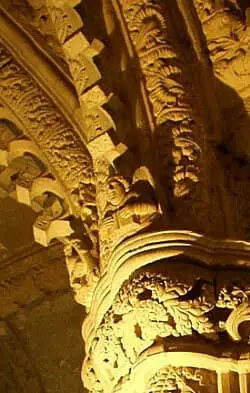- Home
- How to Write Music
- Musical Mysteries
8 Musical Mysteries and Phenomena as Inspiration for Music Composition
This article may contain compensated links. Please read the disclosure for more info.
Who doesn't like musical mysteries? Or to sink one's teeth into mysterious music phenomena? Or both!
Well, you need to look no further than the history of music and music theory. Here are 8 mysteries and phenomena in music that may inspire you or at least give you goosebumps!
Inspiring Musical Mysteries
Here is a look at 8 fascinating musical theories, musical mysteries, discoveries, and phenomena, and how they relate to music theory. Maybe you can find inspiration or tools for your composition or music-making here?
1. Harmony of the Spheres
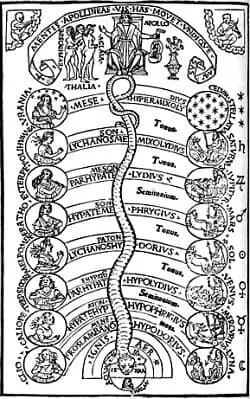 Apollo, the Muses, the planetary spheres and musical modes (Wikipedia)
Apollo, the Muses, the planetary spheres and musical modes (Wikipedia)As far as we know, Pythagoras of Samos (approx. 570 – 495 BC, Greece) was the first to talk about the Harmony of the Spheres.
He and his followers reasoned that all in nature is related to numbers, like the number sequence of Phi.
The mathematical sequences can be found everywhere in nature, including sound and music.
As one of the greatest musical mysteries, it was believed that the movements of the planets and their relative distances created a particular celestial, humming sound.
This sound can't be heard by humans but is thought to be influencing us nevertheless...
In 1619 the mathematician, astronomer, and astrologer Johannes Kepler took this idea further in his treatise «Harmonices Mundi.»
The Picture is an engraving from Renaissance Italy (Gafurius's Practica Musicae, 1496) showing Apollo, the Muses, the planetary spheres, and musical modes (Wikipedia).
"THE HEAVENLY MOTIONS... ARE NOTHING BUT A CONTINUOUS SONG FOR SEVERAL VOICES, PERCEIVED NOT BY THE EAR BUT BY THE INTELLECT, A FIGURED MUSIC WHICH SETS LANDMARKS IN THE IMMEASURABLE FLOW OF TIME."
J. KEPLER
2. The Golden Ratio in Music
The golden cut, ratio, and section - all refer to the mathematical calculation going back to Pythagoras and his Phi 0.618.
In art and music, the golden ratio may be seen as a way to measure a universal sense of beauty and balance.
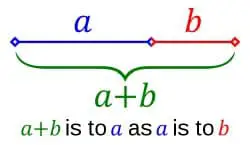 The Golden Ratio
The Golden RatioIn music, the golden ratio can be found in the construction of musical phrases and in the more extensive structure of a sonata form, for example.
If you look at a typical phrase, the melody will move towards a peak or climax of sorts and then go back and get softer or less dramatic.
The climax is often reached approximately 2/3 in the phrase- which can loosely be seen as the Golden ratio.
You can also hear it in a bigger context- listen for where the most complex or dramatic part is in a composition, and you will often find it about 2/3 of the piece!
"The golden ratio is also apparent in the organization of the sections in the music of Debussy's Reflets Dans LL'eau (Reflections in Water), from Images (1st series, 1905), in which the sequence of keys is marked out by the intervals 34, 21, 13 and 8, and the main climax sits at the phi position."
(The dynamics of delight: architecture and aesthetics By Peter Frederick Smith quoted in Wikipedia).
3. Number Symbolism and Other Codes
 The "Bach Cross"
The "Bach Cross"Look at this picture (The "Bach Cross") with J. S Bach's clever signature.
By reading the notes with the correct clef, you will get the notes: B, A, C, and H. (In German, Bb is B, and B is H).
J.S Bach and W.A Mozart liked to doodle with numbers represented by notes, as did and do, many other composers.
Composing the music was easy; the fun part was to «hide» musical mysteries and riddles relative to the music in the notation, For example, relating to a biblical text using numbers and visual symbolism.
Read more about number symbolism here: How composers from Mozart to Bach made their music add up.
4. The Circle of Fifths
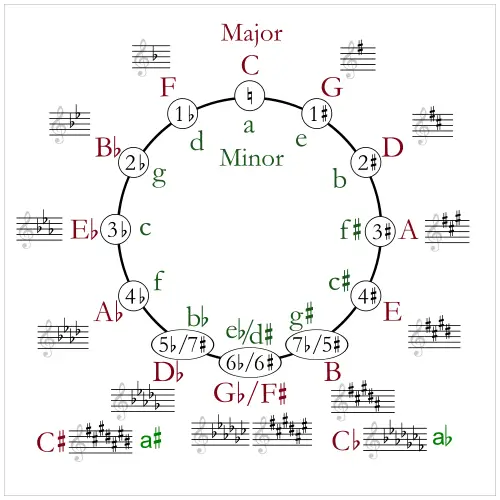 Musical Mysteries: The Circle of Fifths
Musical Mysteries: The Circle of FifthsPythagoras created a valuable tool for musicians with the magical wheel of intervals called the Circle of Fifths.
By repeating perfect fifths one after the other, you return to the starting pitch, just a lot higher, after precisely 12 times.
The easiest way to see this is on a piano. If you start on the lowest C and then play a perfect 5th (precisely 3 ½ steps) higher, you will play a G.
Suppose you continue like this, playing a perfect fifth up each time. In that case, you will play all the 12 different pitches (used in the western notation) in this order: C-G-D-A-E-B-F# (or Gb)- Db-Ab-Eb-Bb-F and back to C.
The circle of fifths is helpful to see how different notes, scales, and chords are related. It also shows all key signatures; for example, C is right next to F and G, the most essential chords for a piece in C major.
5. Overtone Series or Harmonics
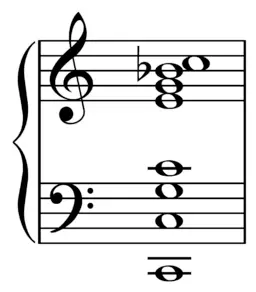 The first eight Harmonics in the overtone series.
The first eight Harmonics in the overtone series.One of natural sound's "musical mysteries" is overtones or harmonics.
Overtones or harmonics are tones that exist in nature and also are "hidden" within a single tone.
It is said that Pythagoras (him again!) "realized" the natural overtone series (and the mathematical sequence they can be represented by) when passing by a blacksmith hammering on metal, creating sounds of different intervals.
Musicians use overtones all the time when tuning or playing their instruments.
You can sometimes hear at least a part of the natural overtone series when the wind blows on the roof and produces a tone and a higher one when the wind blows harder.
Many singers worldwide have learned the art of "overtone singing." (Check out this fantastic singer.)
6. Tritones or "Diabolus In Musica"
A tritone is an interval exactly three whole tones apart. It is called dissonance since it gives you the feeling of wanting to go «somewhere» and does not sound very peaceful. An augmented fourth or a diminished fifth are tritones (and enharmonic!).
During the medieval era, the tritone interval was not recommended when composing music...
This may be since written music was still mainly religious and, as such, striving to be peaceful and contemplative. Still, the tritone sticks out as a somewhat scratchy one!
It has been suggested that the tritone interval has an “erotic” sound (the urge to get solved into a perfect fifth or fourth). With some imagination, you can understand why it was not favored in the times of the Gregorian chants!
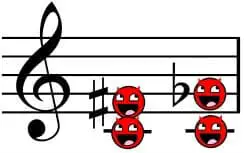
The tritone has been called "Diabolus in Musica" (the devil in music).
This haunting expression was coined sometime during the 18th century, as the tritone had long been considered an awkward interval to compose with and not very pretty.
However, today the tritone is not part of any "musical mysteries" anymore. The tritone interval is used extensively in harmonizing music since it gives a strong feeling of moving forward in a harmonic progression:
The tension (dissonance) leads to a solution (consonance). Like, for example, a tritone interval leading to a minor sixth (expands a semitone in each direction).
7. Cymatics, Patterns of Sound
You probably know that sound is vibration. But did you know that you can capture sound in actual, visual patterns?
The vibration of a pitch in different frequencies can create unique patterns in sand or salt on a metal plate or stretched skin like a drum or any other vibration inductive surface.
8. Architectural Patterns as Secret Sound Codes?
The Rosslyn Chapel in Scotland became even more famous from Dan Brown's "The Da Vinci Code" but is foremost known for its incredible stone carvings and intriguing history.
The Chapel has a series of strangely decorated «boxes» carved in the stone arches.
These little cubes have been suggested showing Cymatic or Chladni patterns representing different pitches.
Musical mysteries or phenomena, Cymatics is not a new invention.
Sound wave patterns in sand on drums, or dust forming patterns on a vibrating table, for example, have been observed thousands of years earlier.
If you really look, you can find what may be patterns of sound all over the world; in ancient hieroglyphs, mandalas, mosaics, and architectural decoration.
And if you really search and listen, you can find musical mysteries and riddles in sound and music; subtle, noticeable, hidden, or even imagined...
Musical mysteries aside, the power of music is unbeatable. Music is magic since it can reach deep into our soul, or as Plato said:
“Music gives a soul to the universe, wings to the mind, flight to the imagination and life to everything.” Plato
